Hypertension: Risk Factors, Complications, and Treatment Approaches
VerifiedAdded on 2023/03/23
|12
|2897
|47
Report
AI Summary
This report provides a comprehensive overview of hypertension, a significant risk factor for cardiovascular and cerebrovascular diseases in adults and the elderly. It explores the multifactorial nature of hypertension, its various stages, and the associated risk factors, including lifestyle, environmental, and genetic influences. The report highlights the importance of understanding hypertension to improve clinical management and emphasizes the increasing prevalence in economically deprived nations while noting a downward trend in developed countries. It delves into the clinical complications such as kidney damage, stroke, and heart attack, and discusses the importance of early detection and management. The report also covers treatment approaches, including lifestyle modifications like dietary adjustments and exercise, as well as pharmacotherapy, with the goal of minimizing the prevalence of hypertension and related complications. Furthermore, the report presents statistical data on hypertension prevalence, awareness, treatment, and control in different countries, along with expected outcomes of treatment interventions.
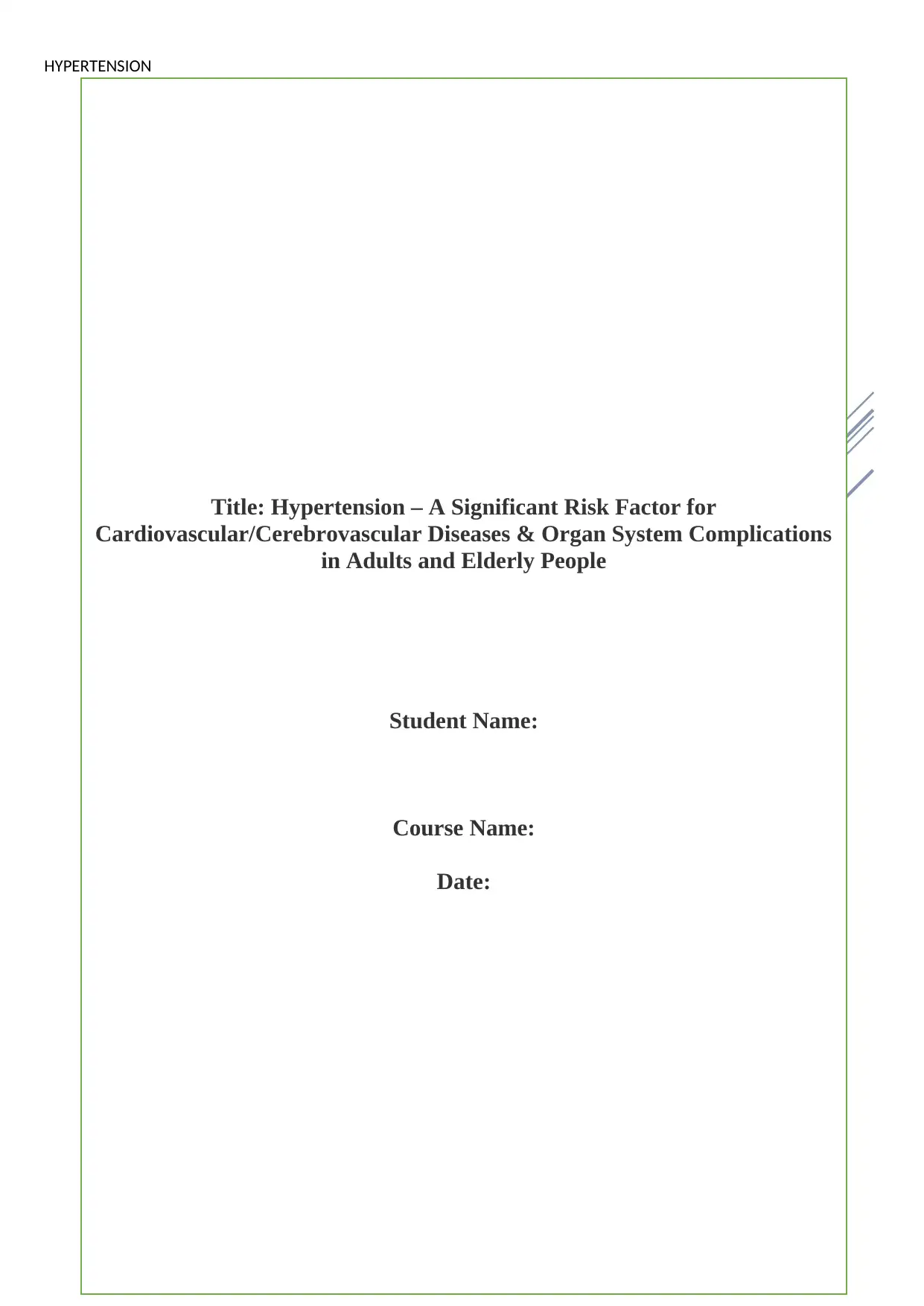
HYPERTENSION
[School]
[Course title]
[Document title]
[Document subtitle]
Title: Hypertension – A Significant Risk Factor for
Cardiovascular/Cerebrovascular Diseases & Organ System Complications
in Adults and Elderly People
Student Name:
Course Name:
Date:
[School]
[Course title]
[Document title]
[Document subtitle]
Title: Hypertension – A Significant Risk Factor for
Cardiovascular/Cerebrovascular Diseases & Organ System Complications
in Adults and Elderly People
Student Name:
Course Name:
Date:
Paraphrase This Document
Need a fresh take? Get an instant paraphrase of this document with our AI Paraphraser
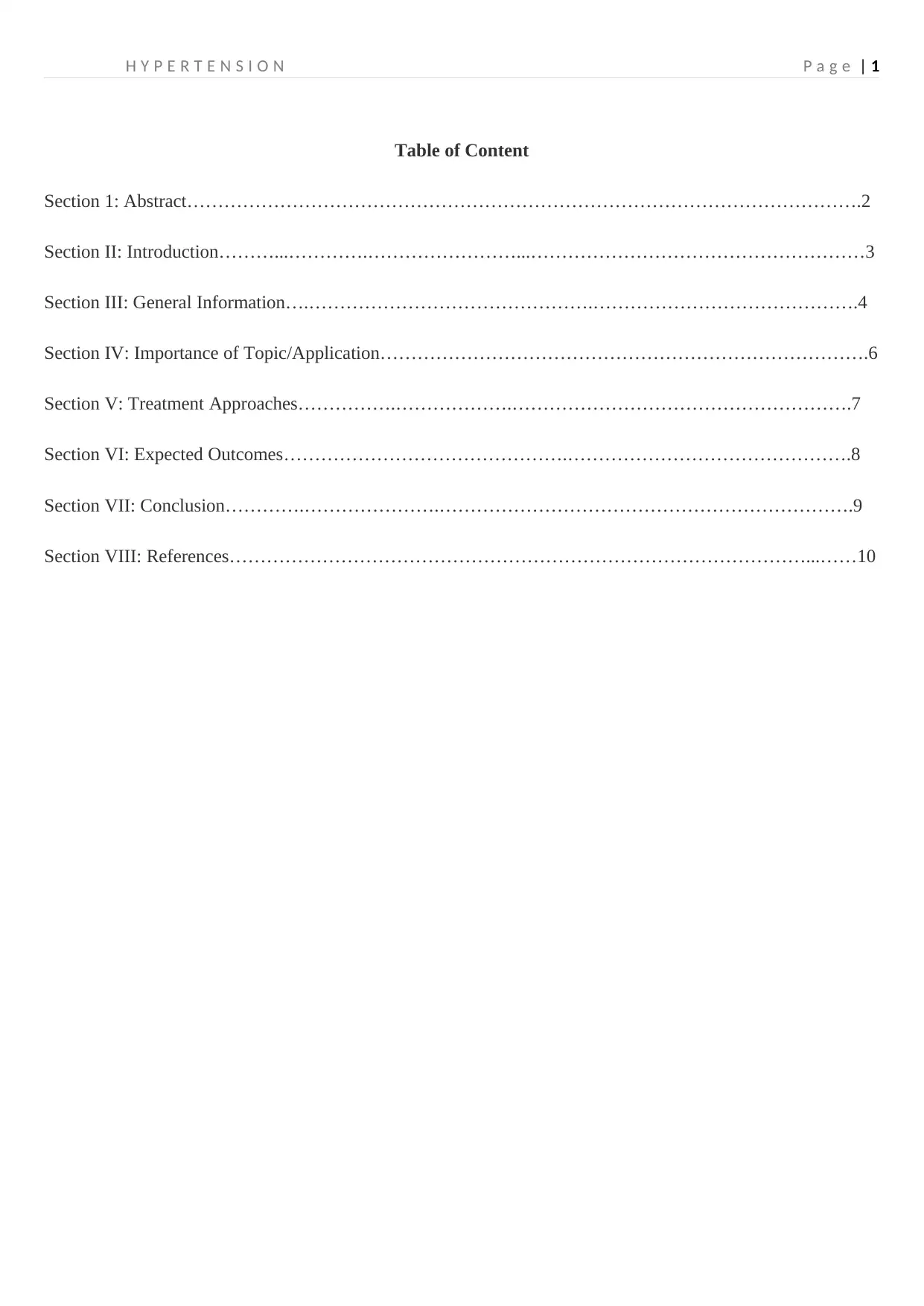
H Y P E R T E N S I O N P a g e | 1
Table of Content
Section 1: Abstract……………………………………………………………………………………………….2
Section II: Introduction………...………….……………………...………………………………………………3
Section III: General Information….……………………………………….…………………………………….4
Section IV: Importance of Topic/Application…………………………………………………………………….6
Section V: Treatment Approaches…………….……………….……………………………………………….7
Section VI: Expected Outcomes……………………………………….……………………………………….8
Section VII: Conclusion………….………………….………………………………………………………….9
Section VIII: References…………………………………………………………………………………...……10
Table of Content
Section 1: Abstract……………………………………………………………………………………………….2
Section II: Introduction………...………….……………………...………………………………………………3
Section III: General Information….……………………………………….…………………………………….4
Section IV: Importance of Topic/Application…………………………………………………………………….6
Section V: Treatment Approaches…………….……………….……………………………………………….7
Section VI: Expected Outcomes……………………………………….……………………………………….8
Section VII: Conclusion………….………………….………………………………………………………….9
Section VIII: References…………………………………………………………………………………...……10

H Y P E R T E N S I O N P a g e | 2
Section I: Abstract
Hypertension is a multifactorial condition that predominantly elevates the risk of various cardiovascular,
cerebrovascular, and organ system complications in adults and elderly individuals of various age groups. The
health care professionals and the patients must improve their insight of hypertension stages in the context of
improving their clinical management. Hypertension and related vascular manifestations substantially impact the
health, wellness, and quality of life of individuals across the USA, Canada, England, and other developed
nations of the world. However, with an increasing awareness of hypertension-related complications, researchers
have noticed a downward trend in hypertension prevalence across various developed countries. Contrarily, the
cases of hypertension continue to rise in economically deprived and impoverished nations of the world.
Comprehensive hypertension management strategies are based on pharmacotherapy, lifestyle modification,
dietary management, and exercise interventions. The health care professionals need to access and evaluate
disease risk factors of adults and elderly people in the context of configuring innovative treatment approaches
for their hypertension management.
Section I: Abstract
Hypertension is a multifactorial condition that predominantly elevates the risk of various cardiovascular,
cerebrovascular, and organ system complications in adults and elderly individuals of various age groups. The
health care professionals and the patients must improve their insight of hypertension stages in the context of
improving their clinical management. Hypertension and related vascular manifestations substantially impact the
health, wellness, and quality of life of individuals across the USA, Canada, England, and other developed
nations of the world. However, with an increasing awareness of hypertension-related complications, researchers
have noticed a downward trend in hypertension prevalence across various developed countries. Contrarily, the
cases of hypertension continue to rise in economically deprived and impoverished nations of the world.
Comprehensive hypertension management strategies are based on pharmacotherapy, lifestyle modification,
dietary management, and exercise interventions. The health care professionals need to access and evaluate
disease risk factors of adults and elderly people in the context of configuring innovative treatment approaches
for their hypertension management.
You're viewing a preview
Unlock full access by subscribing today!
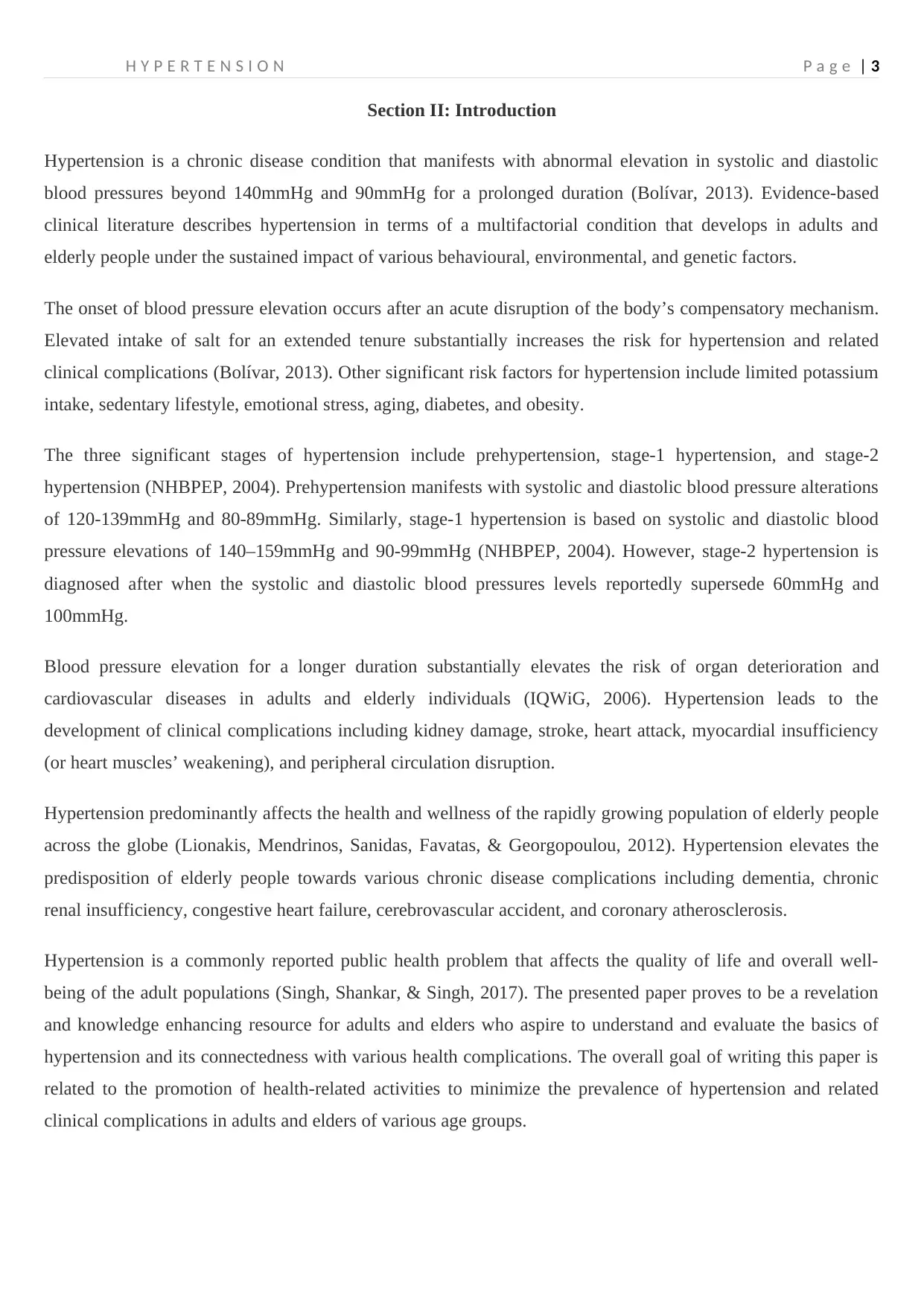
H Y P E R T E N S I O N P a g e | 3
Section II: Introduction
Hypertension is a chronic disease condition that manifests with abnormal elevation in systolic and diastolic
blood pressures beyond 140mmHg and 90mmHg for a prolonged duration (Bolívar, 2013). Evidence-based
clinical literature describes hypertension in terms of a multifactorial condition that develops in adults and
elderly people under the sustained impact of various behavioural, environmental, and genetic factors.
The onset of blood pressure elevation occurs after an acute disruption of the body’s compensatory mechanism.
Elevated intake of salt for an extended tenure substantially increases the risk for hypertension and related
clinical complications (Bolívar, 2013). Other significant risk factors for hypertension include limited potassium
intake, sedentary lifestyle, emotional stress, aging, diabetes, and obesity.
The three significant stages of hypertension include prehypertension, stage-1 hypertension, and stage-2
hypertension (NHBPEP, 2004). Prehypertension manifests with systolic and diastolic blood pressure alterations
of 120-139mmHg and 80-89mmHg. Similarly, stage-1 hypertension is based on systolic and diastolic blood
pressure elevations of 140–159mmHg and 90-99mmHg (NHBPEP, 2004). However, stage-2 hypertension is
diagnosed after when the systolic and diastolic blood pressures levels reportedly supersede 60mmHg and
100mmHg.
Blood pressure elevation for a longer duration substantially elevates the risk of organ deterioration and
cardiovascular diseases in adults and elderly individuals (IQWiG, 2006). Hypertension leads to the
development of clinical complications including kidney damage, stroke, heart attack, myocardial insufficiency
(or heart muscles’ weakening), and peripheral circulation disruption.
Hypertension predominantly affects the health and wellness of the rapidly growing population of elderly people
across the globe (Lionakis, Mendrinos, Sanidas, Favatas, & Georgopoulou, 2012). Hypertension elevates the
predisposition of elderly people towards various chronic disease complications including dementia, chronic
renal insufficiency, congestive heart failure, cerebrovascular accident, and coronary atherosclerosis.
Hypertension is a commonly reported public health problem that affects the quality of life and overall well-
being of the adult populations (Singh, Shankar, & Singh, 2017). The presented paper proves to be a revelation
and knowledge enhancing resource for adults and elders who aspire to understand and evaluate the basics of
hypertension and its connectedness with various health complications. The overall goal of writing this paper is
related to the promotion of health-related activities to minimize the prevalence of hypertension and related
clinical complications in adults and elders of various age groups.
Section II: Introduction
Hypertension is a chronic disease condition that manifests with abnormal elevation in systolic and diastolic
blood pressures beyond 140mmHg and 90mmHg for a prolonged duration (Bolívar, 2013). Evidence-based
clinical literature describes hypertension in terms of a multifactorial condition that develops in adults and
elderly people under the sustained impact of various behavioural, environmental, and genetic factors.
The onset of blood pressure elevation occurs after an acute disruption of the body’s compensatory mechanism.
Elevated intake of salt for an extended tenure substantially increases the risk for hypertension and related
clinical complications (Bolívar, 2013). Other significant risk factors for hypertension include limited potassium
intake, sedentary lifestyle, emotional stress, aging, diabetes, and obesity.
The three significant stages of hypertension include prehypertension, stage-1 hypertension, and stage-2
hypertension (NHBPEP, 2004). Prehypertension manifests with systolic and diastolic blood pressure alterations
of 120-139mmHg and 80-89mmHg. Similarly, stage-1 hypertension is based on systolic and diastolic blood
pressure elevations of 140–159mmHg and 90-99mmHg (NHBPEP, 2004). However, stage-2 hypertension is
diagnosed after when the systolic and diastolic blood pressures levels reportedly supersede 60mmHg and
100mmHg.
Blood pressure elevation for a longer duration substantially elevates the risk of organ deterioration and
cardiovascular diseases in adults and elderly individuals (IQWiG, 2006). Hypertension leads to the
development of clinical complications including kidney damage, stroke, heart attack, myocardial insufficiency
(or heart muscles’ weakening), and peripheral circulation disruption.
Hypertension predominantly affects the health and wellness of the rapidly growing population of elderly people
across the globe (Lionakis, Mendrinos, Sanidas, Favatas, & Georgopoulou, 2012). Hypertension elevates the
predisposition of elderly people towards various chronic disease complications including dementia, chronic
renal insufficiency, congestive heart failure, cerebrovascular accident, and coronary atherosclerosis.
Hypertension is a commonly reported public health problem that affects the quality of life and overall well-
being of the adult populations (Singh, Shankar, & Singh, 2017). The presented paper proves to be a revelation
and knowledge enhancing resource for adults and elders who aspire to understand and evaluate the basics of
hypertension and its connectedness with various health complications. The overall goal of writing this paper is
related to the promotion of health-related activities to minimize the prevalence of hypertension and related
clinical complications in adults and elders of various age groups.
Paraphrase This Document
Need a fresh take? Get an instant paraphrase of this document with our AI Paraphraser
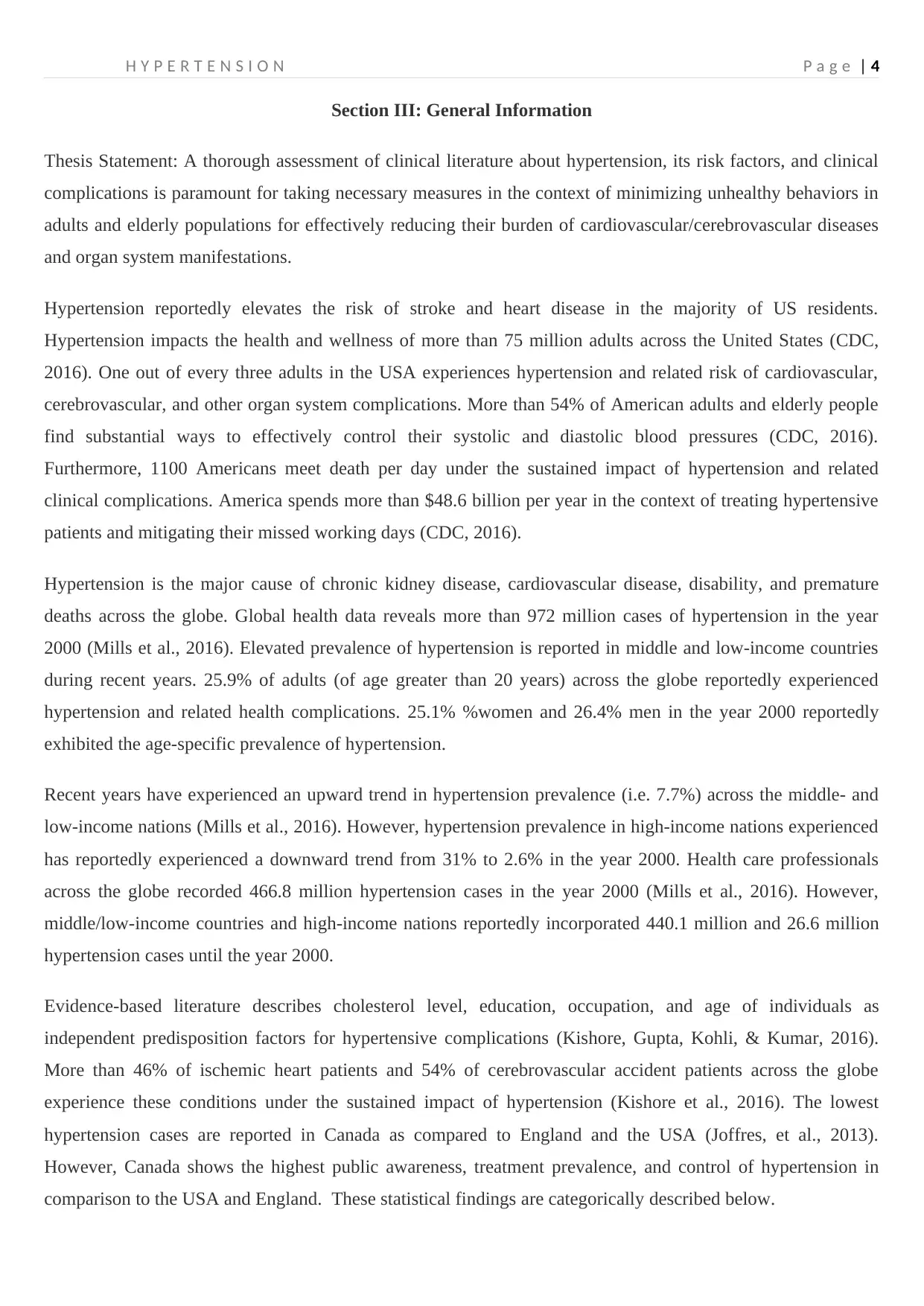
H Y P E R T E N S I O N P a g e | 4
Section III: General Information
Thesis Statement: A thorough assessment of clinical literature about hypertension, its risk factors, and clinical
complications is paramount for taking necessary measures in the context of minimizing unhealthy behaviors in
adults and elderly populations for effectively reducing their burden of cardiovascular/cerebrovascular diseases
and organ system manifestations.
Hypertension reportedly elevates the risk of stroke and heart disease in the majority of US residents.
Hypertension impacts the health and wellness of more than 75 million adults across the United States (CDC,
2016). One out of every three adults in the USA experiences hypertension and related risk of cardiovascular,
cerebrovascular, and other organ system complications. More than 54% of American adults and elderly people
find substantial ways to effectively control their systolic and diastolic blood pressures (CDC, 2016).
Furthermore, 1100 Americans meet death per day under the sustained impact of hypertension and related
clinical complications. America spends more than $48.6 billion per year in the context of treating hypertensive
patients and mitigating their missed working days (CDC, 2016).
Hypertension is the major cause of chronic kidney disease, cardiovascular disease, disability, and premature
deaths across the globe. Global health data reveals more than 972 million cases of hypertension in the year
2000 (Mills et al., 2016). Elevated prevalence of hypertension is reported in middle and low-income countries
during recent years. 25.9% of adults (of age greater than 20 years) across the globe reportedly experienced
hypertension and related health complications. 25.1% %women and 26.4% men in the year 2000 reportedly
exhibited the age-specific prevalence of hypertension.
Recent years have experienced an upward trend in hypertension prevalence (i.e. 7.7%) across the middle- and
low-income nations (Mills et al., 2016). However, hypertension prevalence in high-income nations experienced
has reportedly experienced a downward trend from 31% to 2.6% in the year 2000. Health care professionals
across the globe recorded 466.8 million hypertension cases in the year 2000 (Mills et al., 2016). However,
middle/low-income countries and high-income nations reportedly incorporated 440.1 million and 26.6 million
hypertension cases until the year 2000.
Evidence-based literature describes cholesterol level, education, occupation, and age of individuals as
independent predisposition factors for hypertensive complications (Kishore, Gupta, Kohli, & Kumar, 2016).
More than 46% of ischemic heart patients and 54% of cerebrovascular accident patients across the globe
experience these conditions under the sustained impact of hypertension (Kishore et al., 2016). The lowest
hypertension cases are reported in Canada as compared to England and the USA (Joffres, et al., 2013).
However, Canada shows the highest public awareness, treatment prevalence, and control of hypertension in
comparison to the USA and England. These statistical findings are categorically described below.
Section III: General Information
Thesis Statement: A thorough assessment of clinical literature about hypertension, its risk factors, and clinical
complications is paramount for taking necessary measures in the context of minimizing unhealthy behaviors in
adults and elderly populations for effectively reducing their burden of cardiovascular/cerebrovascular diseases
and organ system manifestations.
Hypertension reportedly elevates the risk of stroke and heart disease in the majority of US residents.
Hypertension impacts the health and wellness of more than 75 million adults across the United States (CDC,
2016). One out of every three adults in the USA experiences hypertension and related risk of cardiovascular,
cerebrovascular, and other organ system complications. More than 54% of American adults and elderly people
find substantial ways to effectively control their systolic and diastolic blood pressures (CDC, 2016).
Furthermore, 1100 Americans meet death per day under the sustained impact of hypertension and related
clinical complications. America spends more than $48.6 billion per year in the context of treating hypertensive
patients and mitigating their missed working days (CDC, 2016).
Hypertension is the major cause of chronic kidney disease, cardiovascular disease, disability, and premature
deaths across the globe. Global health data reveals more than 972 million cases of hypertension in the year
2000 (Mills et al., 2016). Elevated prevalence of hypertension is reported in middle and low-income countries
during recent years. 25.9% of adults (of age greater than 20 years) across the globe reportedly experienced
hypertension and related health complications. 25.1% %women and 26.4% men in the year 2000 reportedly
exhibited the age-specific prevalence of hypertension.
Recent years have experienced an upward trend in hypertension prevalence (i.e. 7.7%) across the middle- and
low-income nations (Mills et al., 2016). However, hypertension prevalence in high-income nations experienced
has reportedly experienced a downward trend from 31% to 2.6% in the year 2000. Health care professionals
across the globe recorded 466.8 million hypertension cases in the year 2000 (Mills et al., 2016). However,
middle/low-income countries and high-income nations reportedly incorporated 440.1 million and 26.6 million
hypertension cases until the year 2000.
Evidence-based literature describes cholesterol level, education, occupation, and age of individuals as
independent predisposition factors for hypertensive complications (Kishore, Gupta, Kohli, & Kumar, 2016).
More than 46% of ischemic heart patients and 54% of cerebrovascular accident patients across the globe
experience these conditions under the sustained impact of hypertension (Kishore et al., 2016). The lowest
hypertension cases are reported in Canada as compared to England and the USA (Joffres, et al., 2013).
However, Canada shows the highest public awareness, treatment prevalence, and control of hypertension in
comparison to the USA and England. These statistical findings are categorically described below.
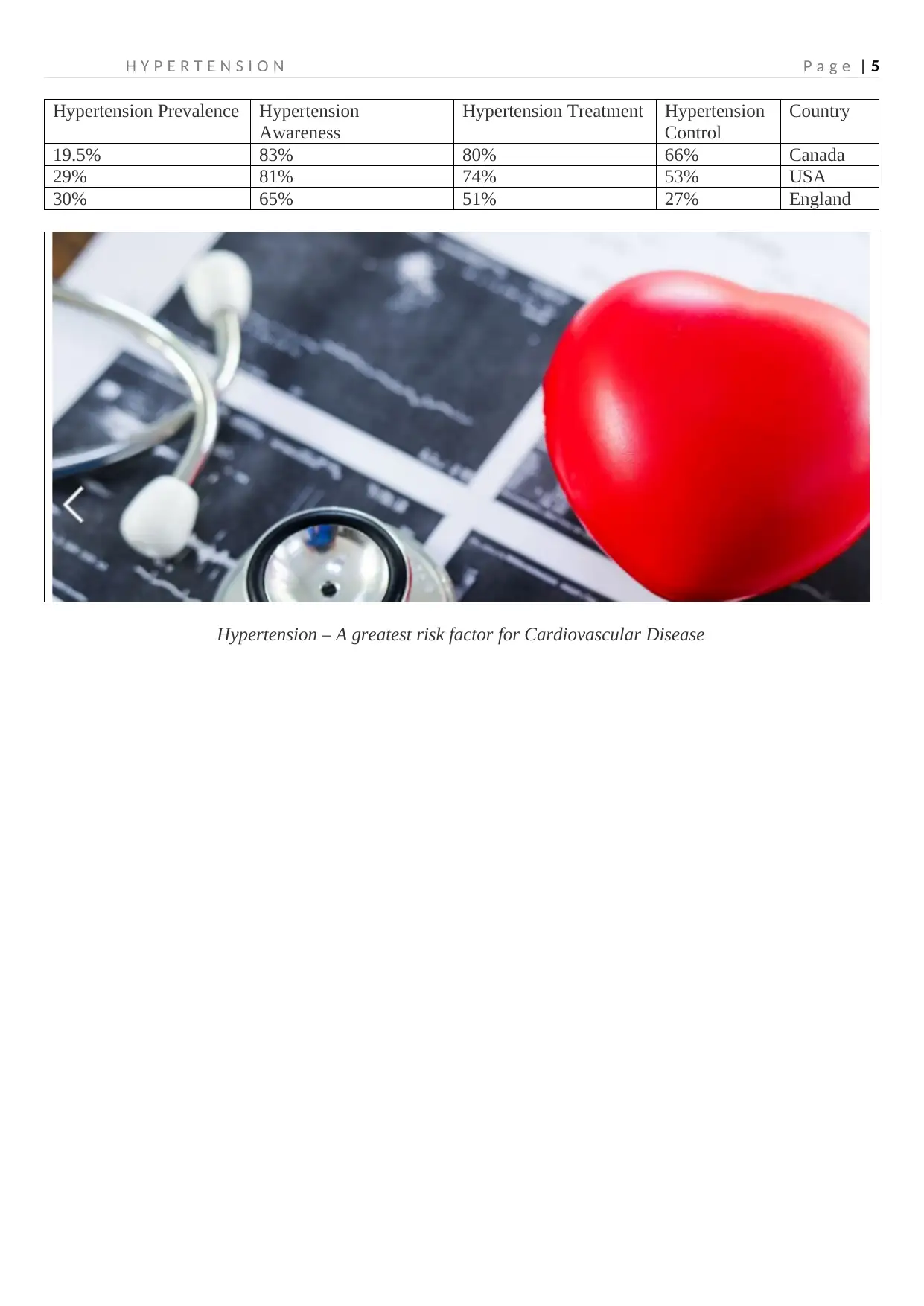
H Y P E R T E N S I O N P a g e | 5
Hypertension Prevalence Hypertension
Awareness
Hypertension Treatment Hypertension
Control
Country
19.5% 83% 80% 66% Canada
29% 81% 74% 53% USA
30% 65% 51% 27% England
Hypertension – A greatest risk factor for Cardiovascular Disease
Hypertension Prevalence Hypertension
Awareness
Hypertension Treatment Hypertension
Control
Country
19.5% 83% 80% 66% Canada
29% 81% 74% 53% USA
30% 65% 51% 27% England
Hypertension – A greatest risk factor for Cardiovascular Disease
You're viewing a preview
Unlock full access by subscribing today!
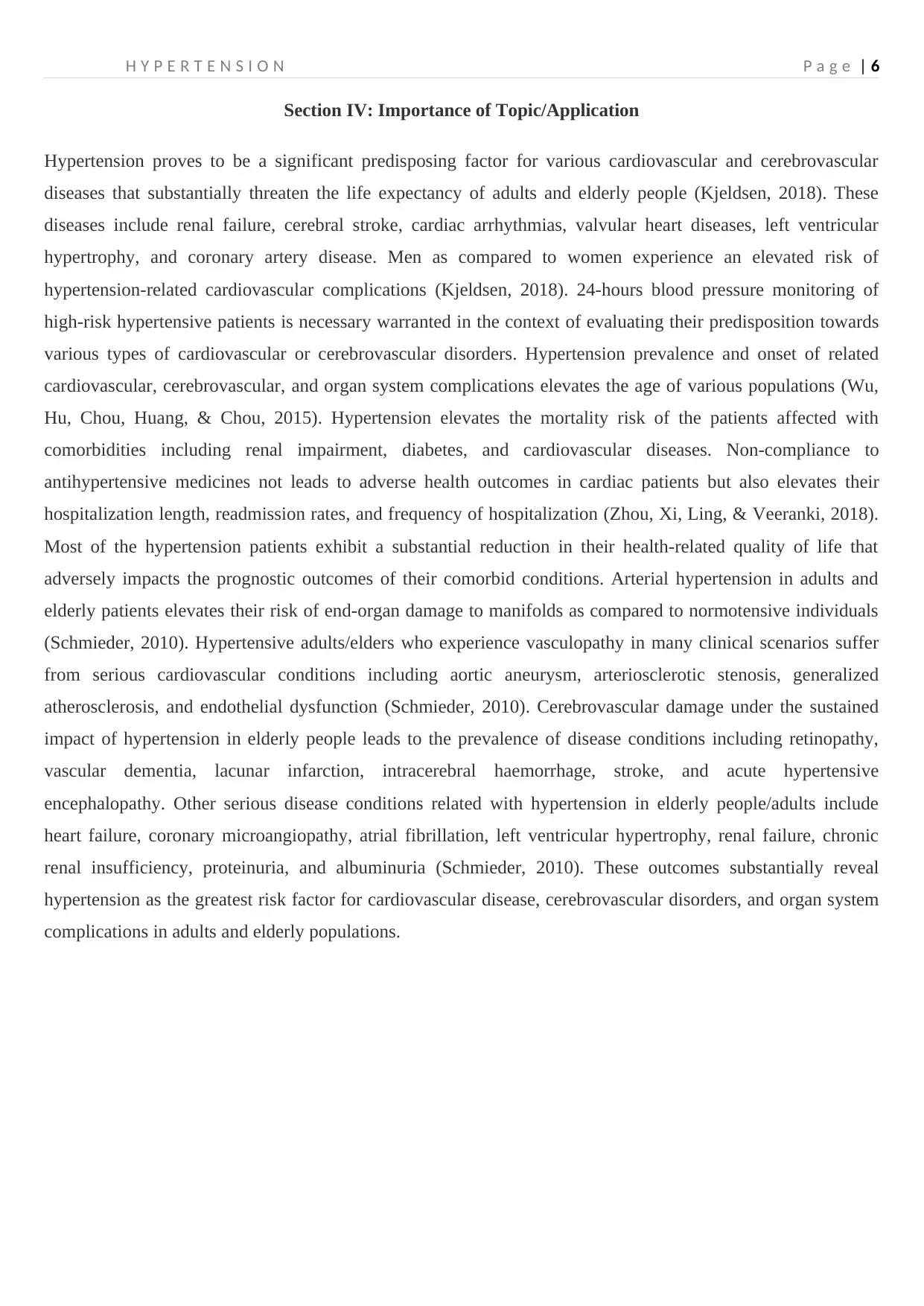
H Y P E R T E N S I O N P a g e | 6
Section IV: Importance of Topic/Application
Hypertension proves to be a significant predisposing factor for various cardiovascular and cerebrovascular
diseases that substantially threaten the life expectancy of adults and elderly people (Kjeldsen, 2018). These
diseases include renal failure, cerebral stroke, cardiac arrhythmias, valvular heart diseases, left ventricular
hypertrophy, and coronary artery disease. Men as compared to women experience an elevated risk of
hypertension-related cardiovascular complications (Kjeldsen, 2018). 24-hours blood pressure monitoring of
high-risk hypertensive patients is necessary warranted in the context of evaluating their predisposition towards
various types of cardiovascular or cerebrovascular disorders. Hypertension prevalence and onset of related
cardiovascular, cerebrovascular, and organ system complications elevates the age of various populations (Wu,
Hu, Chou, Huang, & Chou, 2015). Hypertension elevates the mortality risk of the patients affected with
comorbidities including renal impairment, diabetes, and cardiovascular diseases. Non-compliance to
antihypertensive medicines not leads to adverse health outcomes in cardiac patients but also elevates their
hospitalization length, readmission rates, and frequency of hospitalization (Zhou, Xi, Ling, & Veeranki, 2018).
Most of the hypertension patients exhibit a substantial reduction in their health-related quality of life that
adversely impacts the prognostic outcomes of their comorbid conditions. Arterial hypertension in adults and
elderly patients elevates their risk of end-organ damage to manifolds as compared to normotensive individuals
(Schmieder, 2010). Hypertensive adults/elders who experience vasculopathy in many clinical scenarios suffer
from serious cardiovascular conditions including aortic aneurysm, arteriosclerotic stenosis, generalized
atherosclerosis, and endothelial dysfunction (Schmieder, 2010). Cerebrovascular damage under the sustained
impact of hypertension in elderly people leads to the prevalence of disease conditions including retinopathy,
vascular dementia, lacunar infarction, intracerebral haemorrhage, stroke, and acute hypertensive
encephalopathy. Other serious disease conditions related with hypertension in elderly people/adults include
heart failure, coronary microangiopathy, atrial fibrillation, left ventricular hypertrophy, renal failure, chronic
renal insufficiency, proteinuria, and albuminuria (Schmieder, 2010). These outcomes substantially reveal
hypertension as the greatest risk factor for cardiovascular disease, cerebrovascular disorders, and organ system
complications in adults and elderly populations.
Section IV: Importance of Topic/Application
Hypertension proves to be a significant predisposing factor for various cardiovascular and cerebrovascular
diseases that substantially threaten the life expectancy of adults and elderly people (Kjeldsen, 2018). These
diseases include renal failure, cerebral stroke, cardiac arrhythmias, valvular heart diseases, left ventricular
hypertrophy, and coronary artery disease. Men as compared to women experience an elevated risk of
hypertension-related cardiovascular complications (Kjeldsen, 2018). 24-hours blood pressure monitoring of
high-risk hypertensive patients is necessary warranted in the context of evaluating their predisposition towards
various types of cardiovascular or cerebrovascular disorders. Hypertension prevalence and onset of related
cardiovascular, cerebrovascular, and organ system complications elevates the age of various populations (Wu,
Hu, Chou, Huang, & Chou, 2015). Hypertension elevates the mortality risk of the patients affected with
comorbidities including renal impairment, diabetes, and cardiovascular diseases. Non-compliance to
antihypertensive medicines not leads to adverse health outcomes in cardiac patients but also elevates their
hospitalization length, readmission rates, and frequency of hospitalization (Zhou, Xi, Ling, & Veeranki, 2018).
Most of the hypertension patients exhibit a substantial reduction in their health-related quality of life that
adversely impacts the prognostic outcomes of their comorbid conditions. Arterial hypertension in adults and
elderly patients elevates their risk of end-organ damage to manifolds as compared to normotensive individuals
(Schmieder, 2010). Hypertensive adults/elders who experience vasculopathy in many clinical scenarios suffer
from serious cardiovascular conditions including aortic aneurysm, arteriosclerotic stenosis, generalized
atherosclerosis, and endothelial dysfunction (Schmieder, 2010). Cerebrovascular damage under the sustained
impact of hypertension in elderly people leads to the prevalence of disease conditions including retinopathy,
vascular dementia, lacunar infarction, intracerebral haemorrhage, stroke, and acute hypertensive
encephalopathy. Other serious disease conditions related with hypertension in elderly people/adults include
heart failure, coronary microangiopathy, atrial fibrillation, left ventricular hypertrophy, renal failure, chronic
renal insufficiency, proteinuria, and albuminuria (Schmieder, 2010). These outcomes substantially reveal
hypertension as the greatest risk factor for cardiovascular disease, cerebrovascular disorders, and organ system
complications in adults and elderly populations.
Paraphrase This Document
Need a fresh take? Get an instant paraphrase of this document with our AI Paraphraser
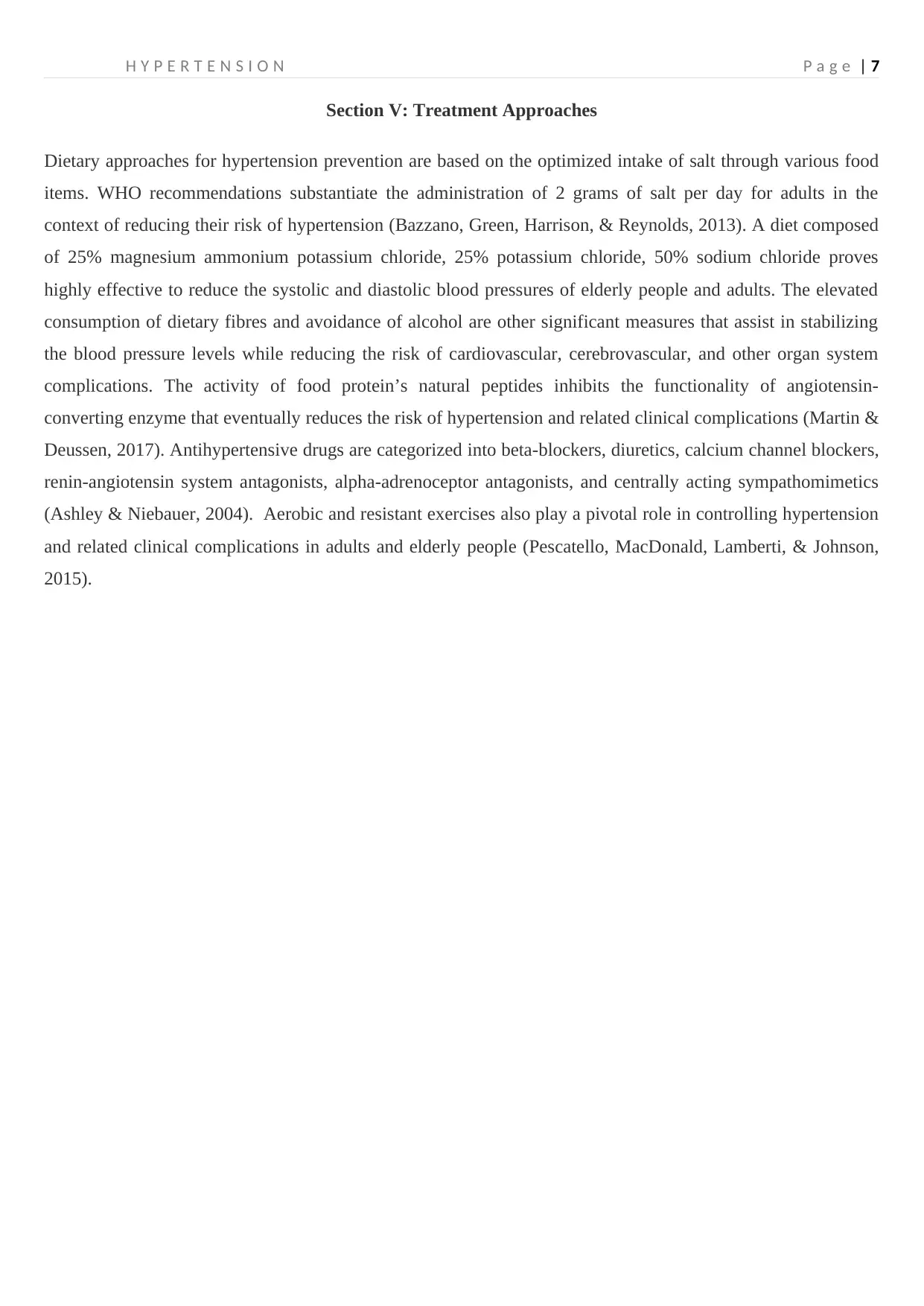
H Y P E R T E N S I O N P a g e | 7
Section V: Treatment Approaches
Dietary approaches for hypertension prevention are based on the optimized intake of salt through various food
items. WHO recommendations substantiate the administration of 2 grams of salt per day for adults in the
context of reducing their risk of hypertension (Bazzano, Green, Harrison, & Reynolds, 2013). A diet composed
of 25% magnesium ammonium potassium chloride, 25% potassium chloride, 50% sodium chloride proves
highly effective to reduce the systolic and diastolic blood pressures of elderly people and adults. The elevated
consumption of dietary fibres and avoidance of alcohol are other significant measures that assist in stabilizing
the blood pressure levels while reducing the risk of cardiovascular, cerebrovascular, and other organ system
complications. The activity of food protein’s natural peptides inhibits the functionality of angiotensin-
converting enzyme that eventually reduces the risk of hypertension and related clinical complications (Martin &
Deussen, 2017). Antihypertensive drugs are categorized into beta-blockers, diuretics, calcium channel blockers,
renin-angiotensin system antagonists, alpha-adrenoceptor antagonists, and centrally acting sympathomimetics
(Ashley & Niebauer, 2004). Aerobic and resistant exercises also play a pivotal role in controlling hypertension
and related clinical complications in adults and elderly people (Pescatello, MacDonald, Lamberti, & Johnson,
2015).
Section V: Treatment Approaches
Dietary approaches for hypertension prevention are based on the optimized intake of salt through various food
items. WHO recommendations substantiate the administration of 2 grams of salt per day for adults in the
context of reducing their risk of hypertension (Bazzano, Green, Harrison, & Reynolds, 2013). A diet composed
of 25% magnesium ammonium potassium chloride, 25% potassium chloride, 50% sodium chloride proves
highly effective to reduce the systolic and diastolic blood pressures of elderly people and adults. The elevated
consumption of dietary fibres and avoidance of alcohol are other significant measures that assist in stabilizing
the blood pressure levels while reducing the risk of cardiovascular, cerebrovascular, and other organ system
complications. The activity of food protein’s natural peptides inhibits the functionality of angiotensin-
converting enzyme that eventually reduces the risk of hypertension and related clinical complications (Martin &
Deussen, 2017). Antihypertensive drugs are categorized into beta-blockers, diuretics, calcium channel blockers,
renin-angiotensin system antagonists, alpha-adrenoceptor antagonists, and centrally acting sympathomimetics
(Ashley & Niebauer, 2004). Aerobic and resistant exercises also play a pivotal role in controlling hypertension
and related clinical complications in adults and elderly people (Pescatello, MacDonald, Lamberti, & Johnson,
2015).
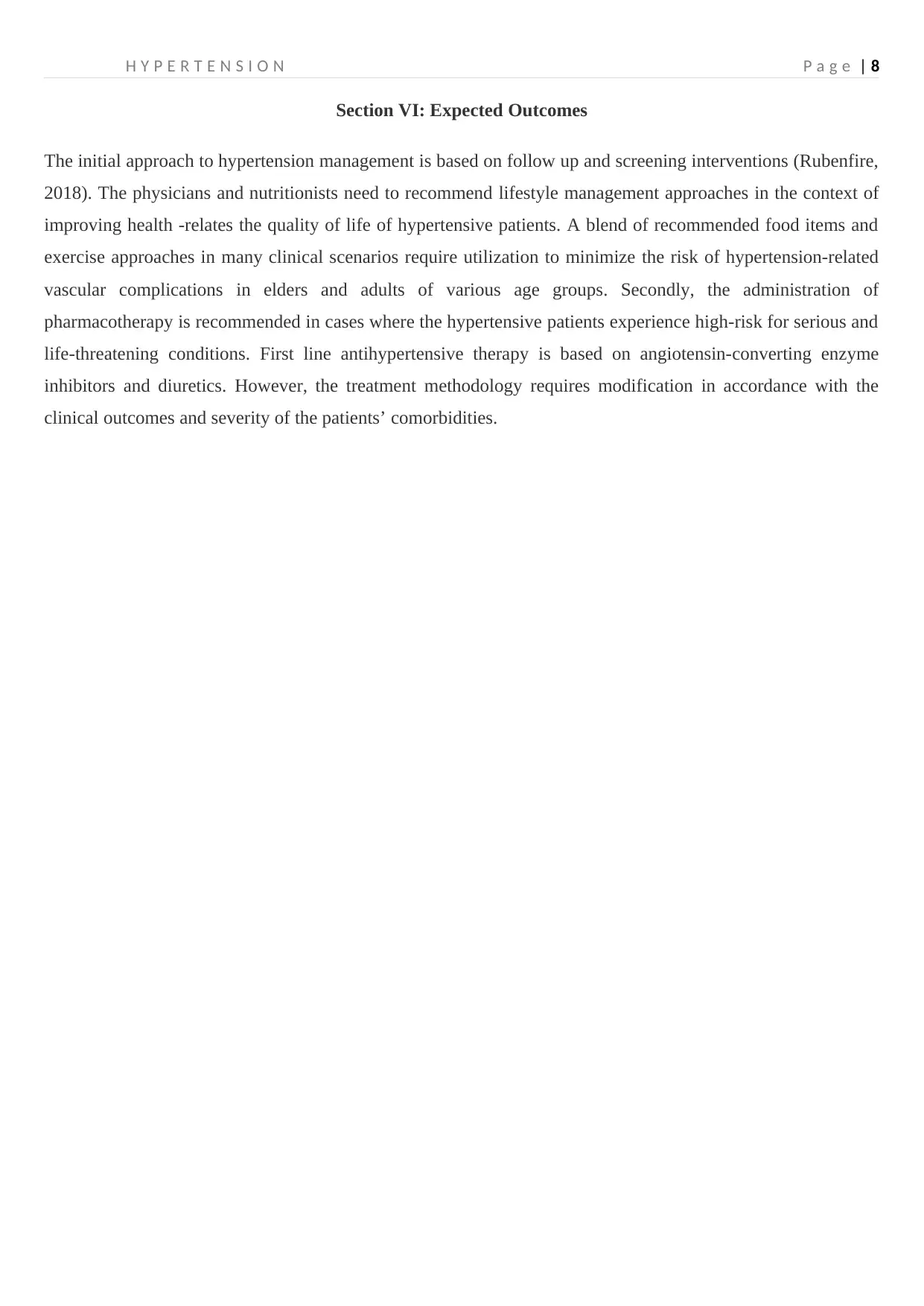
H Y P E R T E N S I O N P a g e | 8
Section VI: Expected Outcomes
The initial approach to hypertension management is based on follow up and screening interventions (Rubenfire,
2018). The physicians and nutritionists need to recommend lifestyle management approaches in the context of
improving health -relates the quality of life of hypertensive patients. A blend of recommended food items and
exercise approaches in many clinical scenarios require utilization to minimize the risk of hypertension-related
vascular complications in elders and adults of various age groups. Secondly, the administration of
pharmacotherapy is recommended in cases where the hypertensive patients experience high-risk for serious and
life-threatening conditions. First line antihypertensive therapy is based on angiotensin-converting enzyme
inhibitors and diuretics. However, the treatment methodology requires modification in accordance with the
clinical outcomes and severity of the patients’ comorbidities.
Section VI: Expected Outcomes
The initial approach to hypertension management is based on follow up and screening interventions (Rubenfire,
2018). The physicians and nutritionists need to recommend lifestyle management approaches in the context of
improving health -relates the quality of life of hypertensive patients. A blend of recommended food items and
exercise approaches in many clinical scenarios require utilization to minimize the risk of hypertension-related
vascular complications in elders and adults of various age groups. Secondly, the administration of
pharmacotherapy is recommended in cases where the hypertensive patients experience high-risk for serious and
life-threatening conditions. First line antihypertensive therapy is based on angiotensin-converting enzyme
inhibitors and diuretics. However, the treatment methodology requires modification in accordance with the
clinical outcomes and severity of the patients’ comorbidities.
You're viewing a preview
Unlock full access by subscribing today!
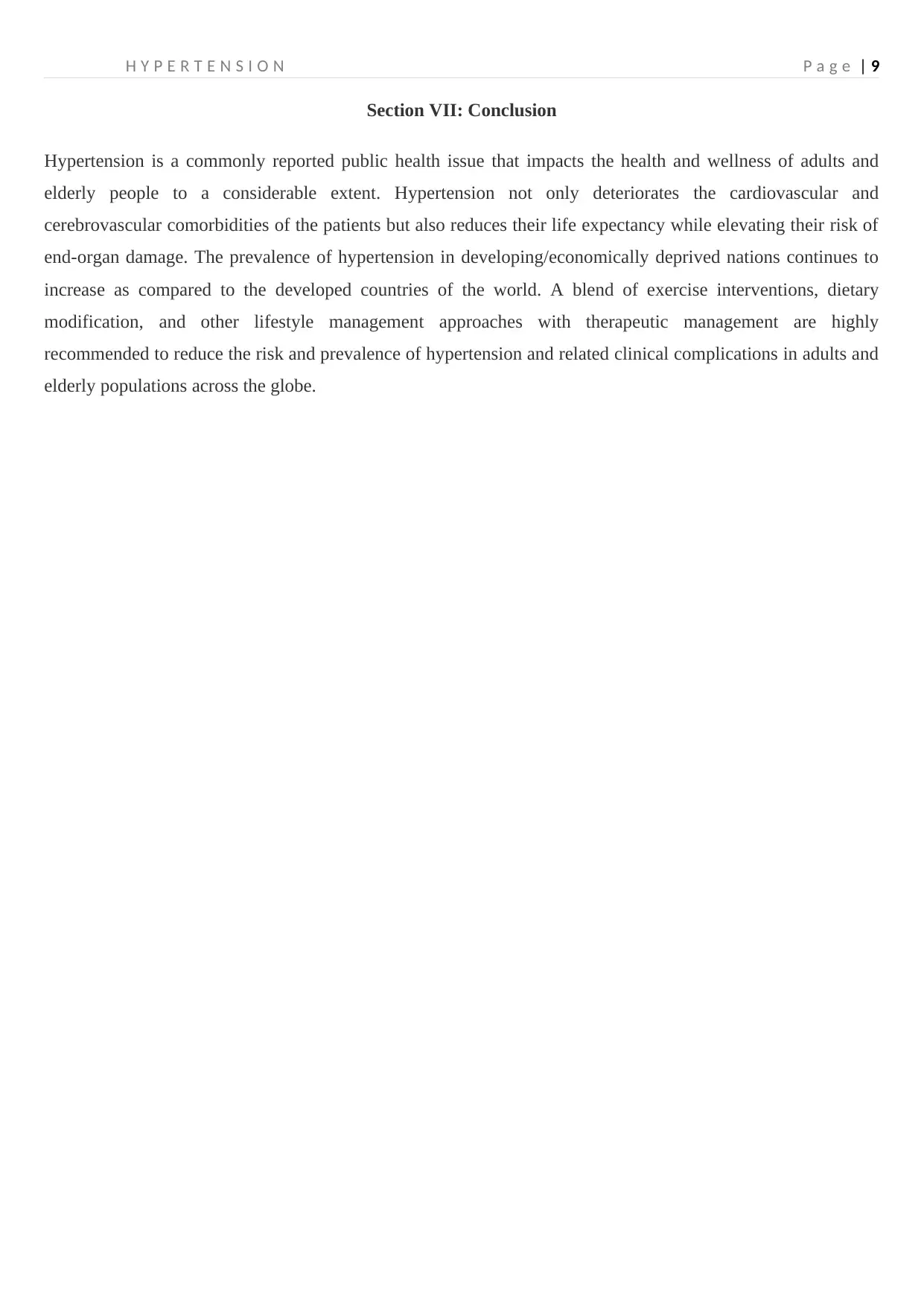
H Y P E R T E N S I O N P a g e | 9
Section VII: Conclusion
Hypertension is a commonly reported public health issue that impacts the health and wellness of adults and
elderly people to a considerable extent. Hypertension not only deteriorates the cardiovascular and
cerebrovascular comorbidities of the patients but also reduces their life expectancy while elevating their risk of
end-organ damage. The prevalence of hypertension in developing/economically deprived nations continues to
increase as compared to the developed countries of the world. A blend of exercise interventions, dietary
modification, and other lifestyle management approaches with therapeutic management are highly
recommended to reduce the risk and prevalence of hypertension and related clinical complications in adults and
elderly populations across the globe.
Section VII: Conclusion
Hypertension is a commonly reported public health issue that impacts the health and wellness of adults and
elderly people to a considerable extent. Hypertension not only deteriorates the cardiovascular and
cerebrovascular comorbidities of the patients but also reduces their life expectancy while elevating their risk of
end-organ damage. The prevalence of hypertension in developing/economically deprived nations continues to
increase as compared to the developed countries of the world. A blend of exercise interventions, dietary
modification, and other lifestyle management approaches with therapeutic management are highly
recommended to reduce the risk and prevalence of hypertension and related clinical complications in adults and
elderly populations across the globe.
Paraphrase This Document
Need a fresh take? Get an instant paraphrase of this document with our AI Paraphraser
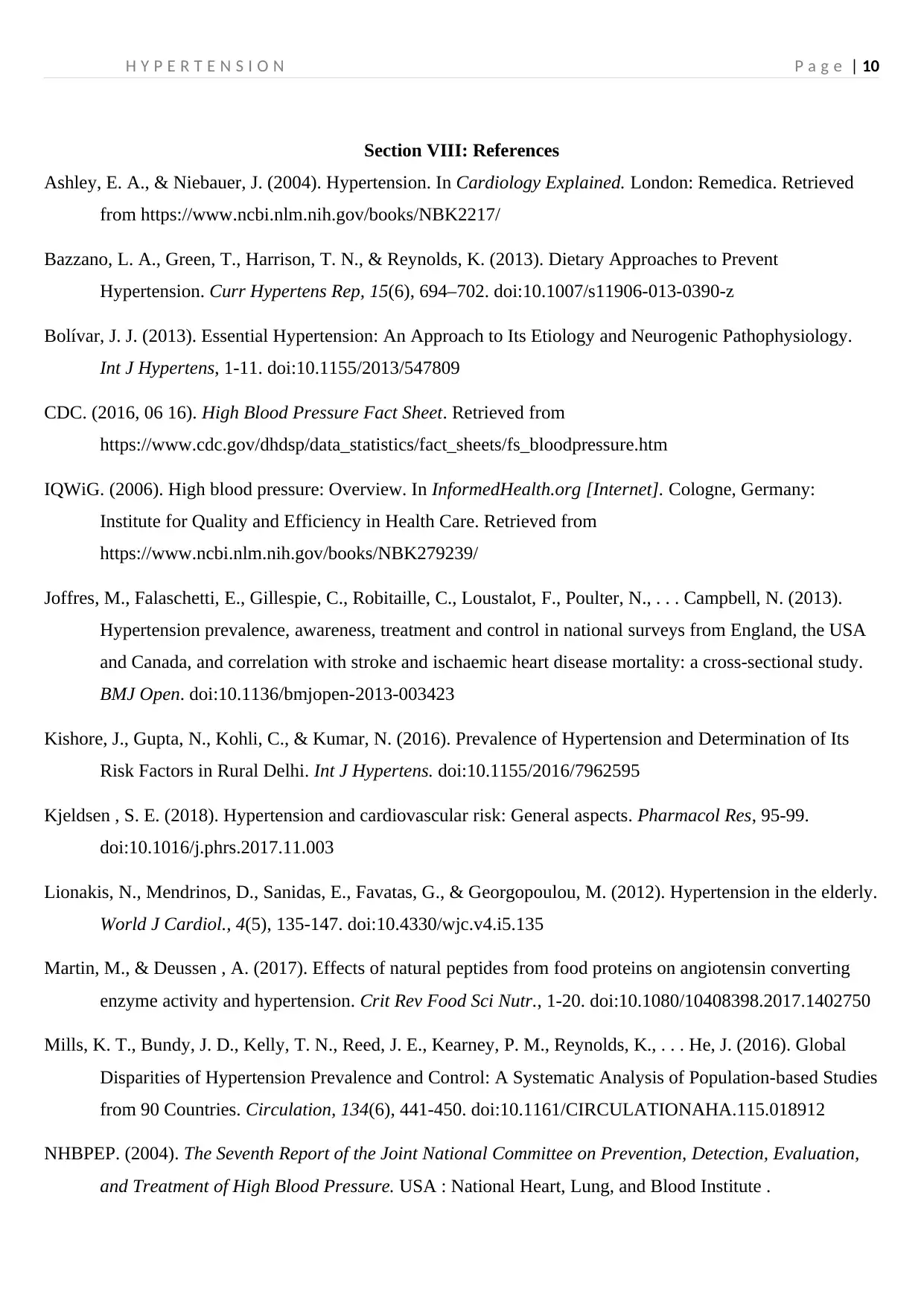
H Y P E R T E N S I O N P a g e | 10
Section VIII: References
Ashley, E. A., & Niebauer, J. (2004). Hypertension. In Cardiology Explained. London: Remedica. Retrieved
from https://www.ncbi.nlm.nih.gov/books/NBK2217/
Bazzano, L. A., Green, T., Harrison, T. N., & Reynolds, K. (2013). Dietary Approaches to Prevent
Hypertension. Curr Hypertens Rep, 15(6), 694–702. doi:10.1007/s11906-013-0390-z
Bolívar, J. J. (2013). Essential Hypertension: An Approach to Its Etiology and Neurogenic Pathophysiology.
Int J Hypertens, 1-11. doi:10.1155/2013/547809
CDC. (2016, 06 16). High Blood Pressure Fact Sheet. Retrieved from
https://www.cdc.gov/dhdsp/data_statistics/fact_sheets/fs_bloodpressure.htm
IQWiG. (2006). High blood pressure: Overview. In InformedHealth.org [Internet]. Cologne, Germany:
Institute for Quality and Efficiency in Health Care. Retrieved from
https://www.ncbi.nlm.nih.gov/books/NBK279239/
Joffres, M., Falaschetti, E., Gillespie, C., Robitaille, C., Loustalot, F., Poulter, N., . . . Campbell, N. (2013).
Hypertension prevalence, awareness, treatment and control in national surveys from England, the USA
and Canada, and correlation with stroke and ischaemic heart disease mortality: a cross-sectional study.
BMJ Open. doi:10.1136/bmjopen-2013-003423
Kishore, J., Gupta, N., Kohli, C., & Kumar, N. (2016). Prevalence of Hypertension and Determination of Its
Risk Factors in Rural Delhi. Int J Hypertens. doi:10.1155/2016/7962595
Kjeldsen , S. E. (2018). Hypertension and cardiovascular risk: General aspects. Pharmacol Res, 95-99.
doi:10.1016/j.phrs.2017.11.003
Lionakis, N., Mendrinos, D., Sanidas, E., Favatas, G., & Georgopoulou, M. (2012). Hypertension in the elderly.
World J Cardiol., 4(5), 135-147. doi:10.4330/wjc.v4.i5.135
Martin, M., & Deussen , A. (2017). Effects of natural peptides from food proteins on angiotensin converting
enzyme activity and hypertension. Crit Rev Food Sci Nutr., 1-20. doi:10.1080/10408398.2017.1402750
Mills, K. T., Bundy, J. D., Kelly, T. N., Reed, J. E., Kearney, P. M., Reynolds, K., . . . He, J. (2016). Global
Disparities of Hypertension Prevalence and Control: A Systematic Analysis of Population-based Studies
from 90 Countries. Circulation, 134(6), 441-450. doi:10.1161/CIRCULATIONAHA.115.018912
NHBPEP. (2004). The Seventh Report of the Joint National Committee on Prevention, Detection, Evaluation,
and Treatment of High Blood Pressure. USA : National Heart, Lung, and Blood Institute .
Section VIII: References
Ashley, E. A., & Niebauer, J. (2004). Hypertension. In Cardiology Explained. London: Remedica. Retrieved
from https://www.ncbi.nlm.nih.gov/books/NBK2217/
Bazzano, L. A., Green, T., Harrison, T. N., & Reynolds, K. (2013). Dietary Approaches to Prevent
Hypertension. Curr Hypertens Rep, 15(6), 694–702. doi:10.1007/s11906-013-0390-z
Bolívar, J. J. (2013). Essential Hypertension: An Approach to Its Etiology and Neurogenic Pathophysiology.
Int J Hypertens, 1-11. doi:10.1155/2013/547809
CDC. (2016, 06 16). High Blood Pressure Fact Sheet. Retrieved from
https://www.cdc.gov/dhdsp/data_statistics/fact_sheets/fs_bloodpressure.htm
IQWiG. (2006). High blood pressure: Overview. In InformedHealth.org [Internet]. Cologne, Germany:
Institute for Quality and Efficiency in Health Care. Retrieved from
https://www.ncbi.nlm.nih.gov/books/NBK279239/
Joffres, M., Falaschetti, E., Gillespie, C., Robitaille, C., Loustalot, F., Poulter, N., . . . Campbell, N. (2013).
Hypertension prevalence, awareness, treatment and control in national surveys from England, the USA
and Canada, and correlation with stroke and ischaemic heart disease mortality: a cross-sectional study.
BMJ Open. doi:10.1136/bmjopen-2013-003423
Kishore, J., Gupta, N., Kohli, C., & Kumar, N. (2016). Prevalence of Hypertension and Determination of Its
Risk Factors in Rural Delhi. Int J Hypertens. doi:10.1155/2016/7962595
Kjeldsen , S. E. (2018). Hypertension and cardiovascular risk: General aspects. Pharmacol Res, 95-99.
doi:10.1016/j.phrs.2017.11.003
Lionakis, N., Mendrinos, D., Sanidas, E., Favatas, G., & Georgopoulou, M. (2012). Hypertension in the elderly.
World J Cardiol., 4(5), 135-147. doi:10.4330/wjc.v4.i5.135
Martin, M., & Deussen , A. (2017). Effects of natural peptides from food proteins on angiotensin converting
enzyme activity and hypertension. Crit Rev Food Sci Nutr., 1-20. doi:10.1080/10408398.2017.1402750
Mills, K. T., Bundy, J. D., Kelly, T. N., Reed, J. E., Kearney, P. M., Reynolds, K., . . . He, J. (2016). Global
Disparities of Hypertension Prevalence and Control: A Systematic Analysis of Population-based Studies
from 90 Countries. Circulation, 134(6), 441-450. doi:10.1161/CIRCULATIONAHA.115.018912
NHBPEP. (2004). The Seventh Report of the Joint National Committee on Prevention, Detection, Evaluation,
and Treatment of High Blood Pressure. USA : National Heart, Lung, and Blood Institute .
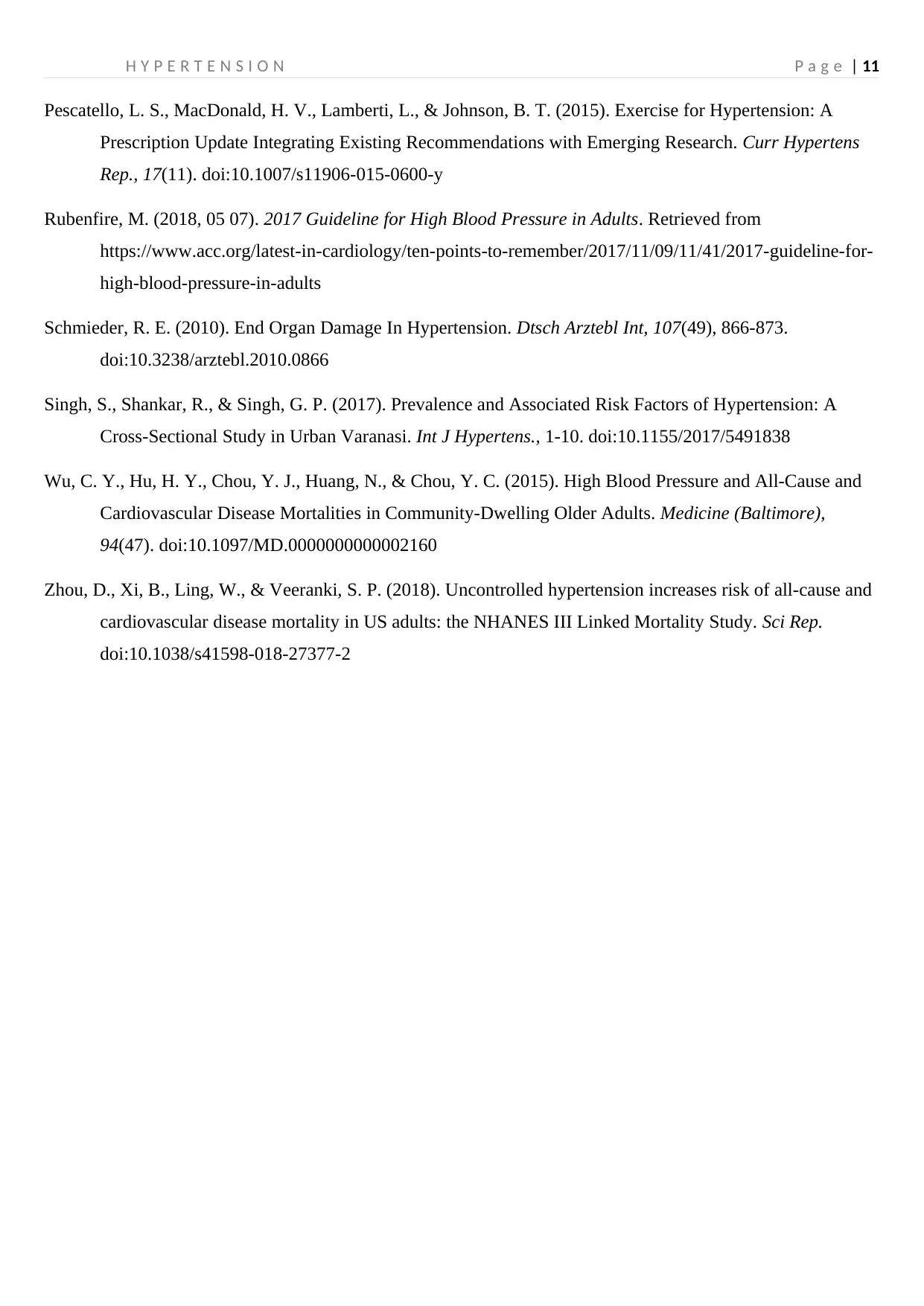
H Y P E R T E N S I O N P a g e | 11
Pescatello, L. S., MacDonald, H. V., Lamberti, L., & Johnson, B. T. (2015). Exercise for Hypertension: A
Prescription Update Integrating Existing Recommendations with Emerging Research. Curr Hypertens
Rep., 17(11). doi:10.1007/s11906-015-0600-y
Rubenfire, M. (2018, 05 07). 2017 Guideline for High Blood Pressure in Adults. Retrieved from
https://www.acc.org/latest-in-cardiology/ten-points-to-remember/2017/11/09/11/41/2017-guideline-for-
high-blood-pressure-in-adults
Schmieder, R. E. (2010). End Organ Damage In Hypertension. Dtsch Arztebl Int, 107(49), 866-873.
doi:10.3238/arztebl.2010.0866
Singh, S., Shankar, R., & Singh, G. P. (2017). Prevalence and Associated Risk Factors of Hypertension: A
Cross-Sectional Study in Urban Varanasi. Int J Hypertens., 1-10. doi:10.1155/2017/5491838
Wu, C. Y., Hu, H. Y., Chou, Y. J., Huang, N., & Chou, Y. C. (2015). High Blood Pressure and All-Cause and
Cardiovascular Disease Mortalities in Community-Dwelling Older Adults. Medicine (Baltimore),
94(47). doi:10.1097/MD.0000000000002160
Zhou, D., Xi, B., Ling, W., & Veeranki, S. P. (2018). Uncontrolled hypertension increases risk of all-cause and
cardiovascular disease mortality in US adults: the NHANES III Linked Mortality Study. Sci Rep.
doi:10.1038/s41598-018-27377-2
Pescatello, L. S., MacDonald, H. V., Lamberti, L., & Johnson, B. T. (2015). Exercise for Hypertension: A
Prescription Update Integrating Existing Recommendations with Emerging Research. Curr Hypertens
Rep., 17(11). doi:10.1007/s11906-015-0600-y
Rubenfire, M. (2018, 05 07). 2017 Guideline for High Blood Pressure in Adults. Retrieved from
https://www.acc.org/latest-in-cardiology/ten-points-to-remember/2017/11/09/11/41/2017-guideline-for-
high-blood-pressure-in-adults
Schmieder, R. E. (2010). End Organ Damage In Hypertension. Dtsch Arztebl Int, 107(49), 866-873.
doi:10.3238/arztebl.2010.0866
Singh, S., Shankar, R., & Singh, G. P. (2017). Prevalence and Associated Risk Factors of Hypertension: A
Cross-Sectional Study in Urban Varanasi. Int J Hypertens., 1-10. doi:10.1155/2017/5491838
Wu, C. Y., Hu, H. Y., Chou, Y. J., Huang, N., & Chou, Y. C. (2015). High Blood Pressure and All-Cause and
Cardiovascular Disease Mortalities in Community-Dwelling Older Adults. Medicine (Baltimore),
94(47). doi:10.1097/MD.0000000000002160
Zhou, D., Xi, B., Ling, W., & Veeranki, S. P. (2018). Uncontrolled hypertension increases risk of all-cause and
cardiovascular disease mortality in US adults: the NHANES III Linked Mortality Study. Sci Rep.
doi:10.1038/s41598-018-27377-2
You're viewing a preview
Unlock full access by subscribing today!
1 out of 12
Related Documents
Your All-in-One AI-Powered Toolkit for Academic Success.
+13062052269
info@desklib.com
Available 24*7 on WhatsApp / Email
![[object Object]](/_next/static/media/star-bottom.7253800d.svg)
Unlock your academic potential
© 2024 | Zucol Services PVT LTD | All rights reserved.





